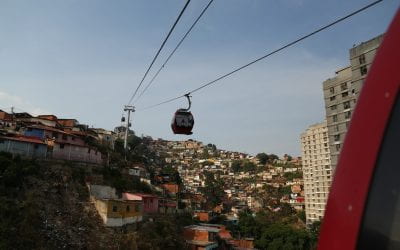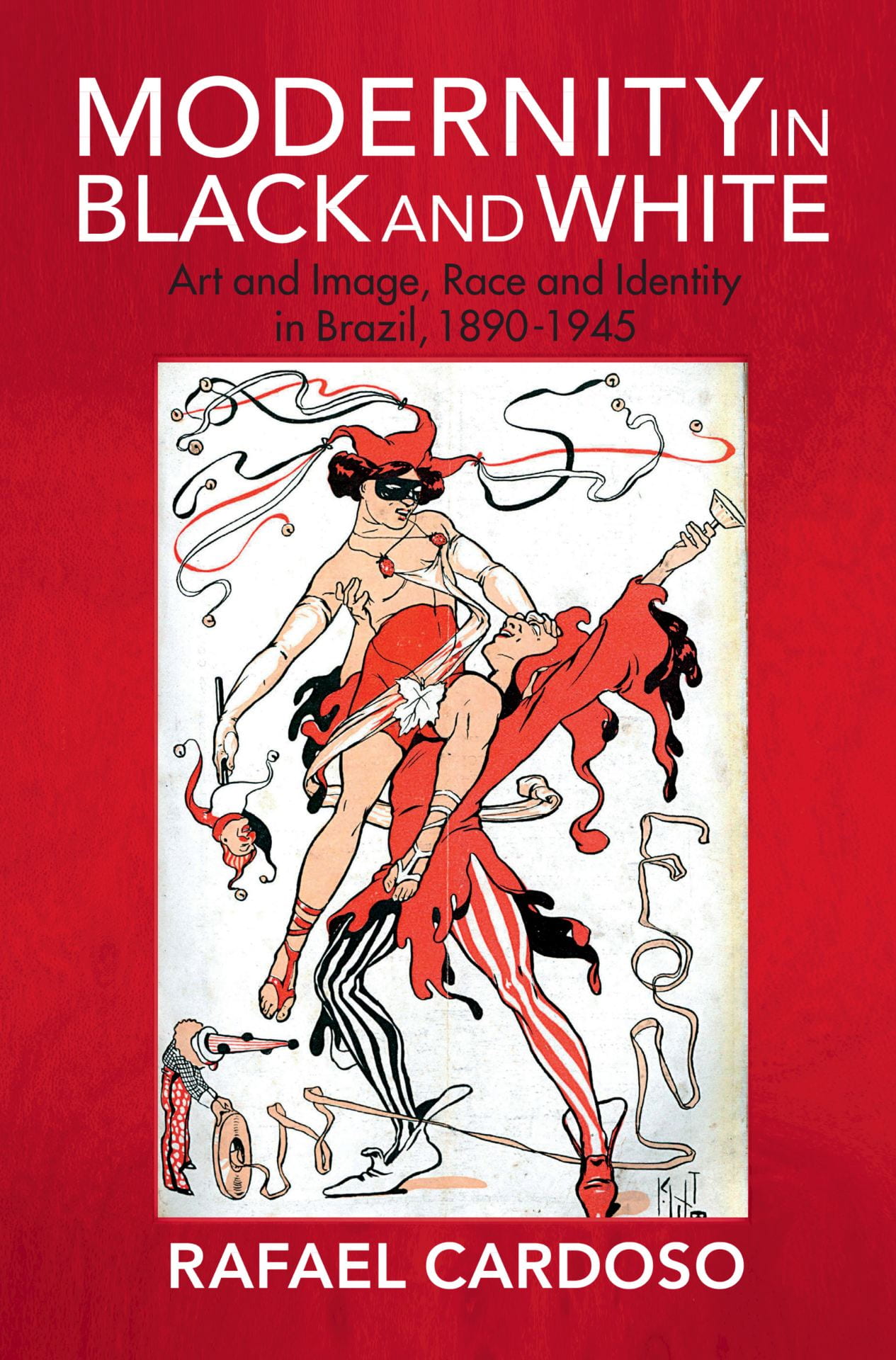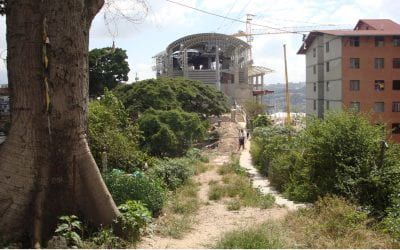Walking the City
A Bad Knee and Making a Walkability Index
I’m a few months away from my sixtieth birthday. It’s not long before I become a member of that group we catalogue in Venezuela as “seniors,” literally, “the third age.” In my city, Caracas, getting old means a significant loss of mobility for those of us who get around on foot. That’s not so much because of a decline in physical ability that getting old implies, but because of the obstacles the city puts in our way. Mobility is restricted and many are sentenced to being shut in. That particularly affects those who live in zones constructed in the absence of the state, and when the state sporadically appears, it does so offering bandaids, rather than structural solutions.
I’m about to be in the senior category, but the truth is it doesn’t matter much because I’ve always been a walker, as if walking would connect me with the fountain of eternal youth. Like it would enter into a great collective vibration that would annul the concept of time. As if to form part of this “well of electricity,” as the French poet Charles Baudelaire described in the mid-19th century in his book The Painter of Modern Life. The thousands of obstacles in my city are not important to me because walking gives a purpose to my existence. Because of this, I am a militant pedestrian: I want to live in a city centered around people and I fight against everything that goes against that desire.

(Nelson González Leal @negole) (Avenida Carabobo, El Rosal, Caracas) In Caracas—and Venezuela in general—it is a common practice to park blocking pedestrian walkways.
For sure, I never imagined that I would form part of another vulnerable group in our city and so many Latin American cities: that of people with disabilities.
Knee “on the rocks”
An old injury in my right knee has been bothering me for the last few weeks. It has its ups-and-downs: it is never completely okay, and sometimes it really hurts, which means that I have to apply ice-pack therapies. When the knee is bothering me, my range of motion is drastically reduced, and it is difficult to step onto a curb that is six to eight inches tall, which is adequate in technical terms: sufficiently low not to be an obstacle for pedestrians, tall enough to separate it from the stream of autos in the street. I say this from a perspective of knowledge: in 2018 I coordinated, with the sponsorship of the CAF Development Bank of Latin America, a study of 100 Caracas roads for the characterizations of their sidewalk curbs, observing and registering very diverse aspects of their physical makeup. Only about one out of every three were in this range of six to eight inches. Another third were above eight inches tall, to the extreme of 15 inches. The other third? Well, they were practically non-existent, leaving no border with the street, transforming more into a discretional space for drivers, rather than providing more space for pedestrians. In the same study, we observed that in city-wide roads only a third had sidewalks that were more than 20 feet wide, while on neighborhood roads, almost 40% only reached five feet wide, sometimes a minimal three feet. Not to mention those that don’t have any width, because they simply don’t exist.

(Nelson González Leal @negole) (Avenida del Ávila, Altamira, Caracas) Very few corners have pedestrian ramps. infrastructure is not designed to increase pedestrian accessibility; rather, it is designed to give order to the car.
In this study, we found many anomalies, all perceived by the society as normal. An example: 80% of access ramps are for vehicles that go across the sidewalk seeking to park, and their size seems to be made for people in wheelchairs. In contrast, pedestrian ramps seem to be constructed only to ward off the thoughtless intrusion of vehicles as they cross into this (sacred?) territory. We add to these findings that at street intersections, 80% of the corners we evaluated do not have ramps. And of these 20% with ramps, with luck, a third complied with technical requirements: a gentle incline, on the same level as the curb, sufficiently wide and free of obstacles.
Now with my poor knee crying out with a S.O.S, I confess, in body and soul, these numbers make me furious.
Institutional Malaise
These statistics are part of a greater malaise. Let’s just add another: 75% of observed urban street furnishings are located in such a way as to become obstacles for pedestrians, especially those with visual and motor disabilities; in the observed area, we found physical evidence of the disappearance of 1,066 trees, but revising the tree pattern along roads, and supposing one tree every 26-33 feet, we can affirm that only half the trees exist that ought to accompany our travels around this tropical city.

(Nelson González Leal @negole) (Avenida Este 10, San Agustín del Norte, Caracas) There still exist far too many narrow sidewalks in Caracas, which additionally contain a series of obstacles which make movement, especially for those with already limited mobility, more difficult.
If the malaise is so bad, why doesn’t the situation change? Why, if anything at all, are there only isolated responses, disconnected initiatives? These statistics are the expression of a problem that is both deep-seated and worrisome, that reveals the institutional incapacity that is not necessarily technical or a matter of resources, but a question of how we produce city, a culture in which its design and implementation normalizes scorn for the pedestrian. The space in which we move today, in which we exist, is what in impeccable Spanish, we call “el repele.” In English, that’s the leftovers, the afterthought, the thing that’s hardly paid attention to.
This does not mean that in Caracas, as in many Latin American cities, that model public spaces where the pedestrian reigns do not exist. That’s not the crux of the problem, but rather the design and distribution of something quite close and ordinary, capable of connecting these plazas, parks and generous pedestrian walkways: the street, which is not only a means to an end. It is not an object, but a collective subject. Let’s put it this way: the great public spaces, in the context of streets that do not share the same spirit, are theatrical spaces in which we citizens make an appearance after crossing through intricate stage machinery filled with all sorts of risks and obstacles. We admire and applaud this happy appearance on stage, but at the cost of keeping concealed what’s backstage.
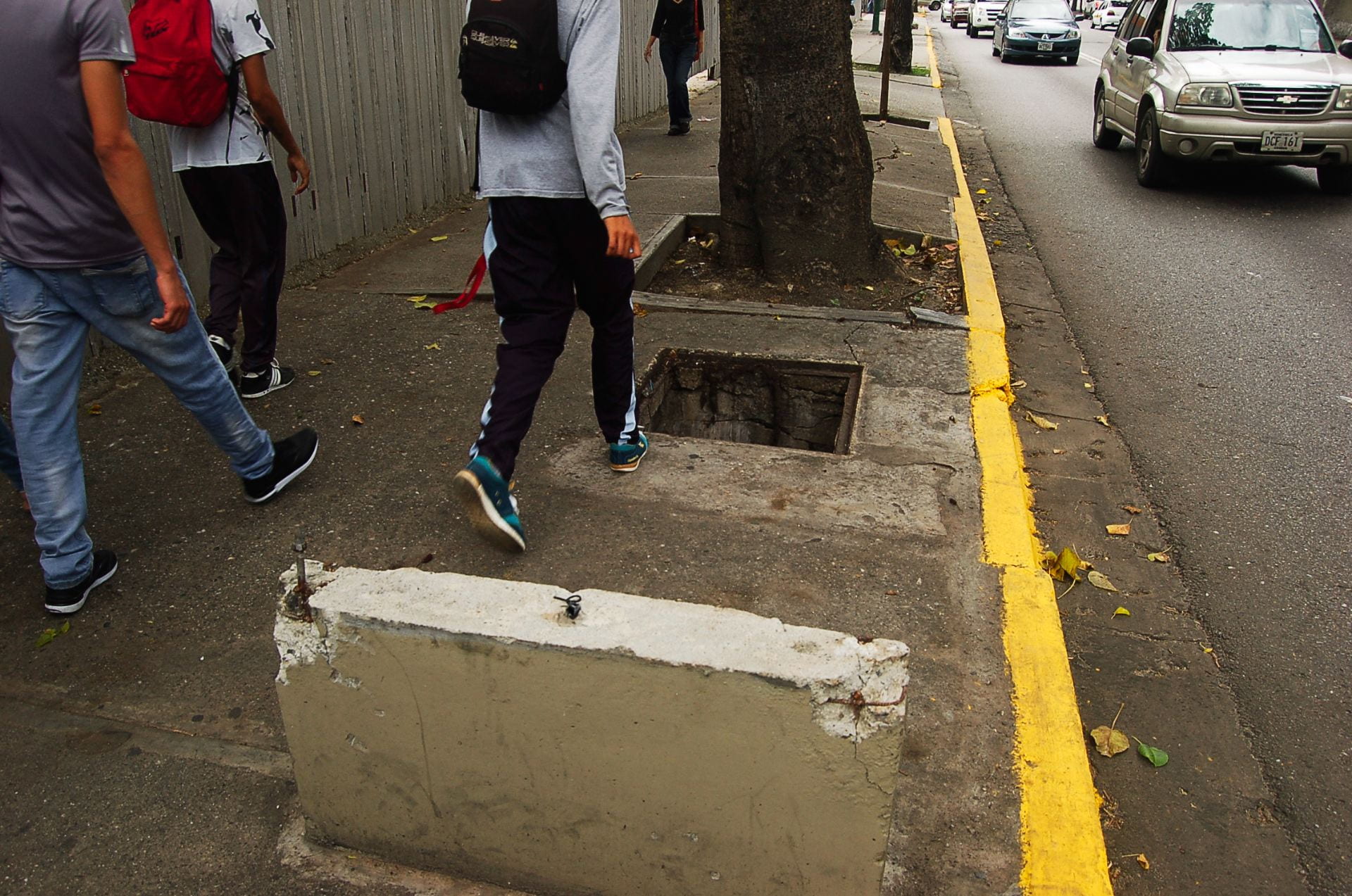
(Nelson González Leal @negole) (Avenida Principal de El Rosal, Caracas) The sidewalks of Caracas contain a whole host of diverse obstacles such as holes, protuberances, and unleveled asphalt.
It’s a good moment to look at U.S. urbanist Jane Jacobs—a theorist who constructed a vision of the city from the stance of activism—to point out, in her words, that the streets and sidewalks are more than simple channels to get between significant spatial milestones, because in reality, “Streets and their sidewalks, the main public spaces of a city, are its most vital organs.”
The undervaluing of streets and sidewalks as fundamental public space—for life and living together as a community—can be directly attributed to those who administer the city, managing (and reproducing) its maladies. In Caracas, few mayors [Caracas has several mayors of districts] actually walk. I’m talking about walking in a conscious, critical and inclusive fashion. A democratic way of walking, as opposed to an electoral way of walking. Moreover, few understand organically the benefits of the urban mixtures that Jacobs defended so strongly. Add to this, the fact that they consider the arbolization of Caracas to be a trivial gesture. In Caracas, trees have been lost systematically over decades, a situation made worse in these times of institutional weaknesses and authoritarianism.
But it is only fair to clarify that behind the politicans are the technocrats and technicians—the urbanists, urban designers, architects, civil engineers, administrators—who cannot dodge their responsibility for not having waged a radical battle, from within the institutions, in favor of walkable cities. This can have many explanations, but I provide one that seems obvious to me: incomprehensibly, few of them walk the city enough and never in a systematic fashion neither during their professional training nor in the exercise of their professional career. Most likely because they have no need to do so (they get around in private vehicles) or because they are afraid of the streets. And while this fact does not change, they will keep on invoking fear and distancing themselves from the people.
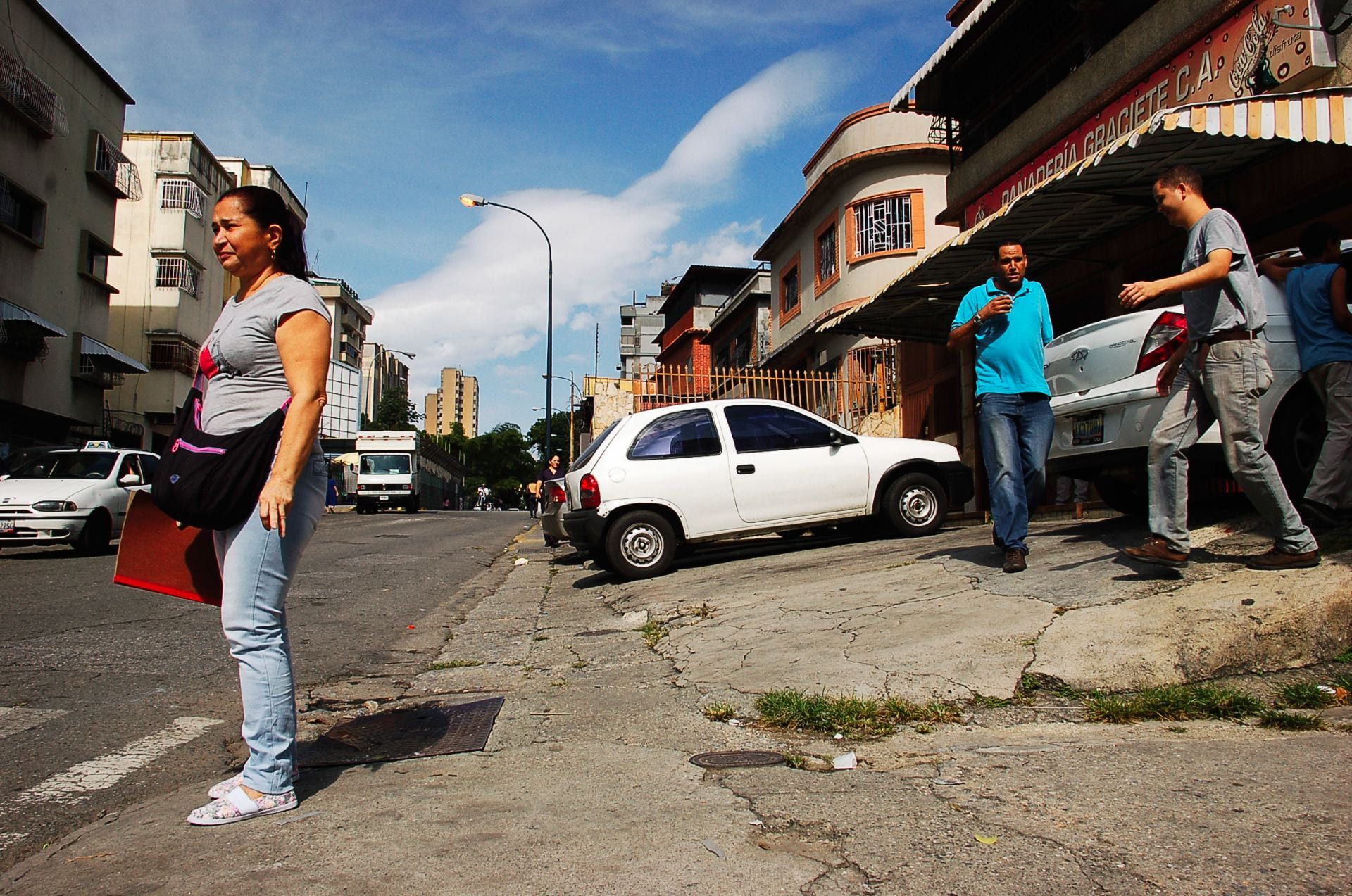
(Nelson González Leal @negole) (La Florida, Caracas) Many times the sidewalk disappears into a continuous plane between driveway and building, used as general parking spots or otherwise inaccessible.
The Construction of a Walkabilty Index
My right knee reminds me of an important moment in the 2018 study I did. After observing and registering the data about the infrastructure of these pedestrian spaces, we took it upon ourselves to construct a walkability index, based on this information. It’s well-known that walkability indexes exist and they tend to be constructed with these premises: how much the street has mixed uses, if its borders are alive and how agreeable the landscape is and friendly to all the senses, as well as some elements of infrastructure such as the width of the sidewalks and the street furnishings available to the walkers such as benches, lighting and bus stops.
The truth is, from this perspective, many of our streets could obtain a high score; among other things, because they are very vibrant, there is a great diversity that seduces those of us who go out to walk, and in fact, many people walk. In Caracas, only one our of every five trips (perhaps even less now in this time of economic crisis and difficulty in obtaining gasoline) are made in private vehicles, around three out of every five trips is on public transportation, and one out of five on foot alone. But every trip on public transportation begins with someone who leaves the door of their home (or work, school, business), walking on the sidewalks. It’s fair to consider the number of pedestrians is actually four out of every five Caracas residents, walking along streets that are mostly designed for and occupied by cars. These figures are not unlike what we encounter in other Latin American cities.
If so many people are walking, why are the streets made to prioritize vehicles and not people? Why is this unequal construction of space perpetuated? Perhaps it can be explained as a mirror image of other more structural inequalities. But surely, important matters would be left out of the conversation such as the fact that most often those who make the decisions in urban management and decision-making do so from the perspective of their cars. Indeed, sometimes—and this is even sadder—those who put on shoes, rather than use wheels, think about and project the city with the automobile within their scheme of things.

(Nelson González Leal @negole) (Puente de Las Mercedes, Caracas) Long sidewalks full of bumps and obstacles are the norm in a significant part of our city, just as in this photo of the bridge Las Mercedes which connects two neighborhoods: Chacao and Baruta.
The city keeps on being thought of as machine that gives the most economic efficiency in terms of the speed of transportation, prioritizing private automobiles. Daily life, sociabilitty and people’s interactions are hardly taken into consideration. Not to mention how little vulnerabilities and the vulnerable are thought of: seniors, children, pregnant women, people with different capacities.
Here I’ll go back to my own vulnerability—my knee—and the attempt to construct a walkability index. As the great majority of people walk, what interests us is to see to what degree infrastructure facilitates or complicates walking in a comfortable, secure way for this massive body in movement. As thinking about these diverse aspects is not an easy task, we decided to contrast our own ruminations with people close to this theme (urbanists, road engineers, activists, people with discapacity, artists). We proposed to consider a total sum of a 100 points to the importance of ramps, crosswalks and stoplights at the intersections; the speed of vehicles on the street; the width and height of sidewalks and curbs; the presence of vehicle access; the location of street furnishings; the presence of obstacles and garbage; road signage in school zones; the presence of trees and the sensorial perception of space.
It was curious to confirm that in general the people consulted indicated the need for a sufficiently “fair” distribution of these points among the factors. A flattening of the assessment. For those of us who developed the study, there were two points of honor: the importants of ramps at the corners, which in and of themselves are an unequivocable symbol of accessibility—for us, there is no sense of talking about walkability without accessibility—and the presence of trees. We were surprised that architects and urbanists gave such a low value to this first factor (between 3 and 6 points), while a person in a wheelchair gave it 10 points (we gave it a 12). Fortunately, there was consensus about the presence of trees.
In this first version, according to our index, only two roads had more than 30 points, three had more than 20 points and the great majority were between 0 and 20. What this reveals is that we are very far from having a city that is generous with those 80% who walk this city every day. It is an index that we need to refine methodologically, but the most important thing is that it revealed to us the process of constuction: who makes the decisions about design and who carries them out or supervises works that have a vision not at all in tune with the “pedestrian cause.” My personal experience confirms that many people involved in city management park their cars on the sidewalks and stop on the pedestrian crosswalk at the red light. Two barbarities that are assumed to be “normal” in a context that calls a pedestrian a “savage” when they are forced to devise infinite strategies to walk, cross and be on the street, always protecting themselves from the automobile, their great antagonist.

(Nelson González Leal @negole) (Colonia de Anzures, sobre la avenida Circuito Interior Melchor Ocampo, CDMX) Antipedestrian bridges exist, not to facilitate pedestrian transportation, but to minimize disruptions to automotive transit. This complicates pedestrian mobility, and prevents many people from even crossing certain streets at all. In many cases, people would prefer to jaywalk where a crosswalk ought to have been, rather than climbing up these rickety structures.
Toward A Walkable City
So what should we do? In principle: train ourselves in walking. I refer to those who do not walk, but make decisions. Or those who research and talk about the subject. It may seem stupid, but it isn’t. There is no way to recognize the importance of walking and of the street as a place of collective coexistence if we do not walk in these spaces. To walk on the sidewalk as one leaves the house connects our body to this great urban matrix; to walk on the street is a form of dancing with other bodies; to stop at the corner—in itself a metaphor for urban diversity; the street is a thread; two streets are a grid—where inevitably we bump into each other and look at each other.
To do one’s part, to get involved, indeed protected by the anonymity afforded by metropolitan life (one of its great attributes), is to begin to construct a better city for everyone. More sustainable. More democratic. Even better if we manage to get those who make decisions about design and urban management out of their cars—and get out of a closed way of thinking. In this, we walk, literally: promoting a pedagogy of walking. And we are not alone in this. In Latin America, there is a vigorous movement harvesting results, bit by bit, and demanding the well-being of the entire city. And for that, my knee is grateful.
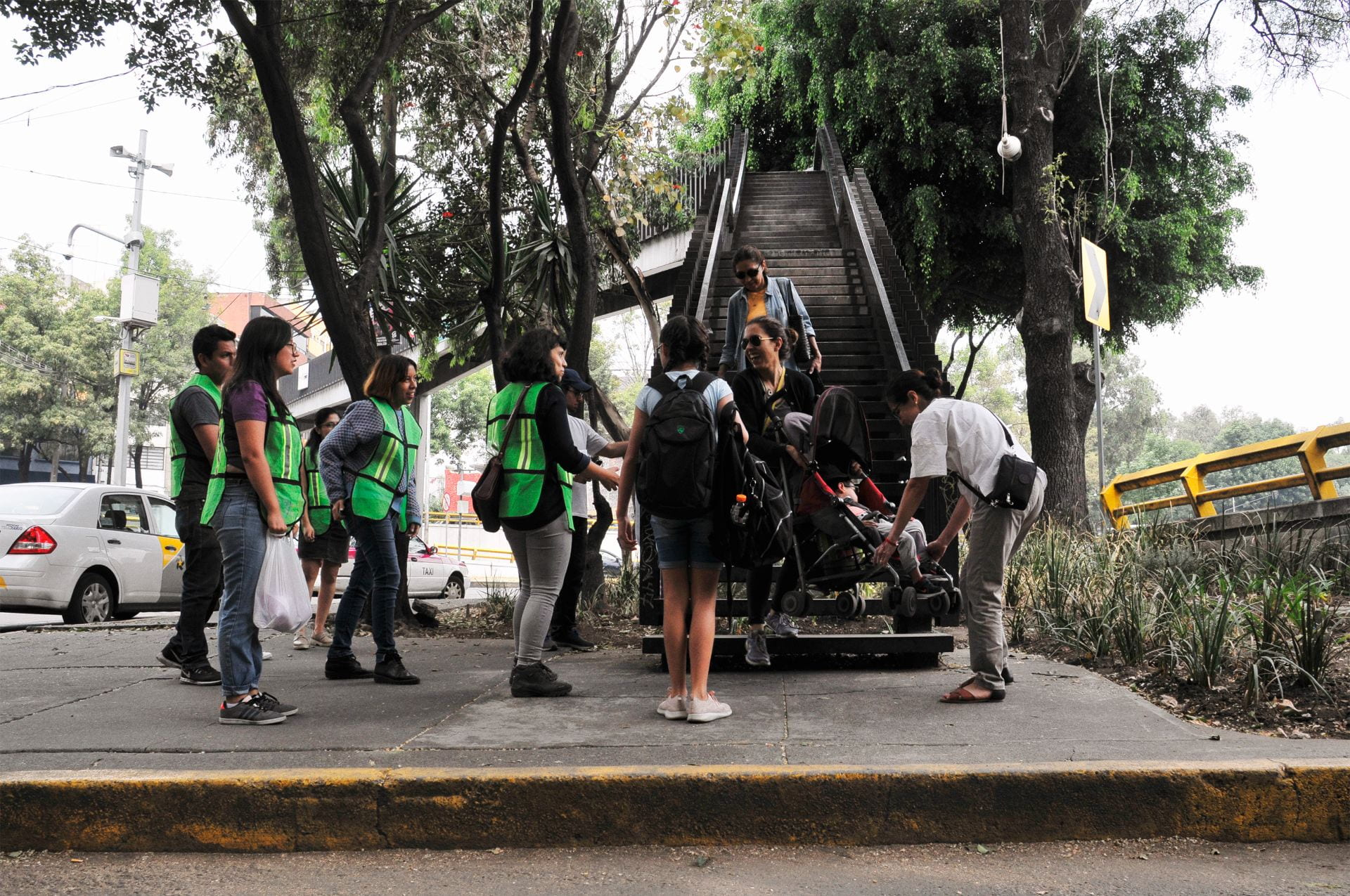
(Nelson González Leal @negole) (Avenida Cuauhtémoc CDMX) In Mexico, the Liga Peatonal—on of the most organized organization for pedestrian rights in Latin America—has developed an intense campaign to call attention to the exclusion this infrastructure causes and argue for its dismantlement. They have already achieved this in some of the cities where they are active.
Andar la ciudad
El malestar de una rodilla y la construcción de un índice de caminabilidad
Por Cheo Carvajal
Estoy a meses de cumplir 60 años. Falta poco para formar parte de ese grupo etario que en Venezuela catalogamos como “tercera edad”. El envejecimiento augura en mi ciudad, Caracas, una significativa pérdida de autonomía para quienes andamos a pie. No tanto por la merma de capacidades físicas que supone el aumento de edad, como por los obstáculos que la ciudad impone. La movilidad se restringe y a muchos condena al encierro. Sobre todo a quienes habitan zonas construidas en ausencia del Estado, y en las que cuando este aparece—esporádicamente—, lo hace con criterios remediales.
Estoy a punto de entrar en esa lista, pero la verdad poco importa porque siempre he andado la calle como si andarla me conectara a la fuente de la eterna juventud. Como si entrara en una gran vibración colectiva que anulara el plano temporal. Como formar parte de ese “pozo de electricidad” que describe el poeta francés Charles Baudelaire, a mediados del siglo XIX, en su libro El pintor de la vida moderna. Camino sin importar los miles de obstáculos en mi ciudad porque andar le da sentido a mi existencia. Por eso soy peatón militante: quiero vivir en una ciudad centrada en la gente y peleo contra aquello que arrebata ese deseo.

(Nelson González Leal @negole) (Avenida Carabobo, El Rosal, Caracas) En Caracas —y en Venezuela en general— es una práctica común que los conductores estacionen sus vehículos obstaculizando los pasos peatonales.
Claro, nunca imaginé formar parte de otro grupo vulnerado en nuestra ciudad, y en tantas ciudades latinoamericanas: el de las “personas con discapacidad”.
Rodilla “on the rocks”
Una vieja lesión en mi rodilla derecha, en mis tiempos de basquetbolista, me ha acosado en las últimas semanas. Tiene sus ciclos: nunca está bien del todo, y cada vez más está fatal, lo que amerita someterla con frecuencia a terapias de frío. En esta temporada la movilidad de mi articulación se ha reducido drásticamente, al punto que me cuesta subir una acera de entre 6 y 8 pulgadas de altura, que es técnicamente la adecuada: suficientemente baja para no ser un obstáculo para quienes caminan, suficientemente alta para separarla del río de automóviles que se desplaza por la calzada. Lo digo desde una mirada acuciosa: en 2018 coordiné, con auspicio de CAF Banco de Desarrollo de América Latina, un estudio en 100 vías de Caracas para la caracterización de sus aceras, observando y registrando muy diversos aspectos de su constitución física. Apenas un tercio estaba en ese rango entre 6 y 8 pulgadas. Por encima de las 8 pulgadas había otro tercio, llegando algunas al extremo de 15 pulgadas. ¿El otro tercio? Pues eran aceras casi inexistentes en las que en muchos casos se borraba la frontera con la calzada, convirtiéndose más en espacio discrecional de los conductores que en ampliación del espacio peatonal. En ese mismo estudio observamos que en vías de escala metropolitana, apenas un tercio tenía un ancho de acera de más de 20 pies, mientras que en calles de escala vecinal cerca de 40% ofrecían un ancho máximo de 5 pies, llegando algunas a un mínimo de 3. Por no hablar de las que sencillamente no tienen ancho, porque no existen.

(Nelson González Leal @negole) (Avenida del Ávila, Altamira, Caracas) Muy pocas esquinas cuentan con rampas peatonales, la infraestructura no está pensada para dar accesibilidad a las personas sino para ordenar el tránsito automotor.
En ese estudio aparecen muchas aberraciones, todas normalizadas. Una de ellas: 80% de las rampas de acceso para vehículos que atraviesan la acera procurando aparcar, parecen hechas para personas en sillas de ruedas. Al contrario, las rampas peatonales parecen hechas para contener el alegre envión de los vehículos cuando ingresan a ese territorio ¿sagrado? Sumemos a ese expediente que en las intersecciones 80% de las esquinas que evaluamos no tenían rampas. Y de ese 20% donde sí estaban presentes, con suerte un tercio cumplían con los requerimientos técnicos: pendiente suave, niveladas con la calzada, suficientemente amplias y libres de obstáculos.
Ahora que mi rodilla lanza un S.O.S. constato, en cuerpo y alma, los números de aquella rabia.

(Nelson González Leal @negole) (Avenida Este 10, San Agustín del Norte, Caracas) Todavía existen demasiadas aceras angostas en Caracas, que además contienen una serie de elementos que obstaculizan los desplazamientos, sobre todo a personas con movilidad reducida.
El malestar institucional
Esos datos son parte de un malestar más amplio. Sumemos dos al expediente: 75% del mobiliario urbano observado estaba ubicado de tal manera que se convertían en obstáculos para caminar y sobre todo para personas con discapacidad visual y motora; en los tramos observados encontramos evidencia física de la desaparición de 1.066 árboles, pero revisando el patrón arbóreo de las vías, suponiendo un árbol cada 26-33 pies, podríamos afirmar que hay la mitad de los árboles que deberían existir y acompañar nuestros recorridos en esta ciudad tropical. Quienes caminamos por estas calles, en las que el sol por momentos parece un látigo ardiente, es importante la sombra de los árboles para caminar.

(Nelson González Leal @negole) (Avenida Principal de El Rosal, Caracas) En las aceras de Caracas hay un catálogo de obstáculos de muy diversas formas y dimensiones, como los que aparecen en esta foto: huecos, protuberancias, desniveles.
Si es tan notorio el malestar, ¿por qué no cambia esta situación? ¿Por qué, a duras penas, aparecen respuestas aisladas, iniciativas desconectadas? Estos datos son expresión de un problema más profundo y preocupante, que revela una incapacidad institucional que no es necesariamente técnica ni de recursos, sino del cómo producimos ciudad, una cultura que en su diseño y gestión normaliza el desprecio al peatón. El espacio por el que hoy nos movemos, en el que estamos, es lo que en perfecto castellano llamaríamos “el repele”.
Eso no quiere decir que en Caracas, al igual que en muchas ciudades latinoamericanas, no haya espacios públicos modélicos en los que el peatón reina a sus anchas. El problema no radica ahí, sino en el diseño y distribución de algo bastante más cercano y cotidiano, capaz de conectar esas plazas, parques y generosos paseos: la calle, que tiene sentido en sí misma porque no es solo un medio. No es un objeto sino un gran sujeto colectivo. Pongámoslo de esta manera: los grandes espacios públicos, en un contexto de calles sin ese espíritu, lucen cual escenarios teatrales en los que los ciudadanos aparecemos luego de atravesar intrincadas tramoyas llenas de todo tipo de riesgos y obstáculos. Admiramos y aplaudimos esa irrupción feliz, al costo de mantener ocultos los entretelones.
Es oportuno acudir a la urbanista estadounidense Jane Jacobs—teórica que construyó una visión de la ciudad desde el activismo–, para señalar con ella que las calles y las aceras son más que simples canales para desplazarse entre significativos hitos espaciales, porque en realidad estas son “los principales espacios públicos de una ciudad, sus órganos más vitales”.

(Nelson González Leal @negole) (La Florida, Caracas) Muchas veces la acera desaparece y es un plano continuo entre calzada y retiro de las edificaciones, utilizado como estacionamiento y ocupando por igual las aceras.
En esta subvaloración de la calle y la acera como espacio público fundamental—para la vida y la convivencia—, tienen responsabilidad directa quienes administran la ciudad, gestionando (y reproduciendo) sus malestares. En Caracas pocos alcaldes la caminan de verdad. Hablo de un caminar consciente, crítico, inclusivo. Un andar democrático —que reconozca a sus pares, que dialogue de manera sostenida—, que poco tiene que ver con un andar electoral, ese que se mueve circunstancialmente en busca de votos. Además, pocos entienden orgánicamente las bondades de las mixturas urbanas que Jacobs tanto defendió. Sumémosle que banalizan la necesidad del arbolado urbano. En Caracas se pierden árboles sistemáticamente desde hace décadas, situación agudizada en estos tiempos de debilidad institucional y autoritarismos. Mientras escribo este texto está ocurriendo una incomprensible sustitución de frondosos árboles por palmas en varios puntos de la ciudad.
Pero es justo aclarar que detrás de los políticos están los técnicos—urbanistas, diseñadores urbanos, arquitectos, ingenieros civiles, administradores—, que no pueden escamotear su responsabilidad por no haber dado una batalla radical, dentro de las instituciones, por ciudades caminables. Esto puede tener muchas explicaciones, pero adelanto una que me resulta obvia: incomprensiblemente pocas y pocos tampoco las caminan lo suficiente, y nunca de manera sistemática, durante su formación ni en su ejercicio profesional. Probablemente porque no tienen necesidad (se mueven en vehículo particular) o porque le temen a la calle. Esa que mientras no se transforma sigue metiendo miedo y distanciando a la gente.

(Nelson González Leal @negole) (Puente de Las Mercedes, Caracas) Aceras estrechas llenas de desniveles y obstáculos: ese es el panorama en buena parte de nuestra ciudad, como en esta imagen del puente de Las Mercedes que une dos municipios: Chacao y Baruta.
La construcción de un índice de caminabilidad
Mi rodilla derecha me hace recordar un momento importante de mi estudio del 2018. Luego de observar y registrar los datos de la infraestructura de esos espacios peatonales, nos aventuramos a construir un índice de caminabilidad, basado en esos aspectos. Es sabido que existen índices de caminabilidad, y que estos suelen hacerse partiendo de estas premisas: cuán mixta es la calle, si sus bordes están vivos, cuán agradable es el paisaje y amable con los sentidos, y algunos elementos de infraestructura, como la amplitud de las aceras y el mobiliario que estas ofrecen al viandante (bancos, iluminación, paradas de transporte público).
La verdad es que, desde ese tipo de lectura, muchas de nuestras calles podrían obtener un alto puntaje, entre otras cosas porque están muy vivas, hay una gran mixtura que seduce a los que andamos, y de facto anda muchísima gente. En Caracas apenas uno de cada cinco viajes (quizás menos en estos tiempos de crisis económica y de dificultades para acceder al combustible) se realizan en vehículo particular, alrededor de tres de cada cinco viajes en transporte público y uno de cada cinco viajes estrictamente a pie. Pero todo viaje en transporte público comienza con alguien que sale por la puerta de su casa (de su trabajo, de su escuela, del comercio) caminando por las aceras, por lo que es justo sumar ese 60% a esos viajes peatonales, llegando entonces a un enorme 80% andando por unas calles ocupadas en tres cuartas partes destinadas a y ocupadas por los automóviles. Eso es lo que vemos en nuestras calles, y estos datos parecen no distanciarse mucho de lo que sucede en otras ciudades latinoamericanas.

(Nelson González Leal @negole) (Colonia de Anzures, sobre la avenida Circuito Interior Melchor Ocampo, CDMX) Los puentes antipeatonales existen, no para facilitar los desplazamientos de las personas, sino para facilitar el tránsito rodado. Esto complica la movilidad peatonal, llegando al extremo de excluir a muchas personas de la posibilidad de cruzar ciertas calles. Muchas veces, entre subir a estas estructuras, incómodas e inseguras, la gente prefiere arriesgarse y pasar por donde, naturalmente, debería estar ubicado el paso peatonal.
¿Si esto es así, por qué las calles están hechas priorizando a los vehículos y no a la gente que camina? ¿Por qué se perpetúa lo que a todas luces es, además, una construcción desigual del espacio? Quizás se pueda explicar como espejo de otras desigualdades más estructurales. Pero con seguridad quedarían por fuera asuntos muy relevantes, como por ejemplo que quienes toman las decisiones en la gestión y en la transformación urbana lo hacen desde el automóvil. Incluso a veces—esto es más triste aún—quienes calzan zapatos en vez de ruedas, piensan y proyectan la ciudad con el auto entre sus dos parietales.
Se sigue pensando en una ciudad-máquina que supone mayor eficacia económica en la velocidad del transporte rodado, priorizando además al automóvil particular. Se piensa mucho menos en la vida cotidiana, en la sociabilidad, en las interacciones de la gente. ¡No se diga cuánto se piensa en las vulnerabilidades y en los vulnerados!: personas mayores, niñas y niños, embarazadas, personas con capacidades diferentes.
Acá vuelvo entonces al asunto de mi propia vulnerabilidad—mi rodilla—y al intento de construir un índice de caminabilidad. Como acá camina la gran mayoría, lo que nos interesaba ver era en qué medida la infraestructura facilitaba o complicaba caminar de manera cómoda, segura, a ese gran cuerpo masivo en movimiento. Como ponderar los diversos aspectos no era asunto fácil, decidimos contrastar nuestra propia ponderación con gente cercana y relevante en estos temas (urbanistas, ingenieros viales, activistas, personas con discapacidad, artistas). Propusimos ponderar con una suma total de 100 puntos la importancia de cada uno de estos factores: rampas, rayados y semáforos en las intersecciones, velocidad de los vehículos en la vía, ancho y alto de las aceras, la presencia de accesos vehiculares, la ubicación del mobiliario, la presencia de obstáculos y desechos, la demarcación vial de zonas educativas, la presencia de árboles y la percepción sensorial del espacio.
Fue curioso constatar que en general la valoración que devolvieron los consultados era una distribución bastante “equitativa” de ese puntaje entre los factores. Un aplanamiento de la valoración. Para quienes desarrollamos el estudio había dos puntos de honor: el peso que debían tener las rampas en las esquinas, que en sí mismas constituyen símbolo inequívoco de accesibilidad—para nosotros no tiene sentido hablar de caminabilidad sin accesibilidad—, y la presencia de los árboles. Nos sorprendió que entre arquitectos y urbanistas le dieran un valor tan bajo a ese factor (entre 3 y 6 puntos), mientras que una persona en silla de ruedas le dio 10 puntos (nosotros 12). Afortunadamente hubo consenso en cuanto a la importancia que tiene la presencia de los árboles.
En esta primera aproximación, según nuestro índice, hubo apenas dos vías que superaron los 30 puntos, tres superaron los 20 puntos y la gran mayoría estuvo entre 0 y 20. Lo que revela que estamos muy lejos de tener una ciudad generosa con ese 80% que todos los días camina por la ciudad. Es un índice que debemos afinar metodológicamente, pero lo más importante fue lo que nos reveló el proceso de construcción: quienes toman decisiones de diseño y quienes ejecutan o supervisan obras tienen una visión muy poco atenta a “la causa peatonal”. Mi experiencia personal ratifica que muchas personas involucradas en la gestión de la ciudad estacionan sus vehículos sobre las aceras y paran sobre el rayado peatonal en el cambio de luz roja. Dos barbaridades que se asumen “normales”, en un contexto que tilda de “salvaje” al peatón que se ve obligado a ingeniar infinitas estrategias para transitar, para cruzar y para estar en la vía, siempre protegiéndose del automóvil, su gran antagonista.

(Nelson González Leal @negole) (Avenida Cuauhtémoc CDMX) En México la Liga Peatonal —una de las organizaciones de defensa de derechos peatonales más consolidadas de Latinoamérica– ha desarrollado una campaña intensa para llamar la atención sobre la exclusión que imponen estos dispositivos anti-peatonales e ir logrando se desmonten. Esto lo han logrado en algunas de sus ciudades que forman parte de esta organización.
Hacia una ciudad caminable
¿Qué hacemos al respecto? En principio: entrenarnos en el andar. Me refiero a quienes no andan y toman decisiones. O a quienes investigan y hablan del tema. Luce tonto, pero no lo es. No hay forma de reconocer la importancia del andar y de la calle como espacio de convivencia, si no nos ejercitamos en ello. Andar la acera que al salir de casa nos conecta desde el cuerpo a esa gran matrix urbana; andar la calle por la que danzamos con otros cuerpos; detenernos en la esquina—en sí misma metáfora de la diversidad urbana: una calle es un hilo, dos calles una trama—donde inevitablemente nos tropezamos y miramos.
Hacer parte, implicarse, incluso resguardados en el anonimato que propone la vida metropolitana y que es parte de sus grandes atributos, es el comienzo para construir una mejor ciudad para todos. Más sostenible. Más democrática. Tanto mejor si logramos que se bajen del automóvil—y lo bajen de sus cabezas—quienes toman decisiones sobre de diseño y gestión urbana. En eso andamos, literalmente: promoviendo una pedagogía del andar. Y no estamos solos en eso. En Latinoamérica hay un movimiento vigoroso cosechando, paso a paso, reivindicaciones para el bienestar de toda la ciudad. Y mi rodilla lo agradece.
Fall 2021, Volume XXI, Number 1
Cheo Carvajal prefers to walk under the shade of trees. A journalist in Caracas, he promotes and defends active mobility. A specialist in themes of public space, he is dirctor of the NGO Laboratory City and Observatory of the Night. @caracasapie / www.ciudlab.com
Cheo Caravajal prefiere andar bajo la sombra de los árboles. Periodista en Caracas, él es defensor/promotor de la movilidad activa. Especializado en temas de espacio público, es director de la ONG Ciudad Laboratorio y del Observatorio de la Noche @caracasapie / www.ciudlab.com
Related Articles
Editor’s Letter: Transportation
Bridges. Highways. Tunnels. Buses. Trains. Subways. Transmilenio. Transcable. When I first started working on this issue of ReVista on Transportation (Volume XXI, No. I), I imagined transportation as infrastructure.
Modernity in Black and White
For years, one of my favorite pieces in the Museo de Arte Latinoamericano de Buenos Aires (MALBA) was the iconic Abaporu (1928), by Brazilian artist Tarsila do Amaral: a canvas…
Transportation Itself Does Not Build Urban Structures
English + Español
Fina Rojas lives in the 19 de Abril at Petare, the densest and one of the largest self-produced neighborhoods in Latin America. Most researchers and policymakers define self-produced neighborhoods as “informal settlements.” However, these settlements occur from…

